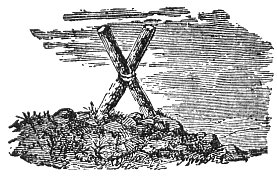The Persians received from the Indians the doctrine of the three principles, and changed it to that of a principle of Life, which was individualized by the Sun, and a principle of Death, which was symbolized by cold and darkness; parallel of the moral world; and in which the continual and alternating struggle between light and darkness, life and death, seemed but a phase of the great struggle between the good and evil principles, embodied in the legend of ORMUZD and AHRIMAN. MITHRAS, a Median reformer, was deified after his death, and invested with the attributes of the Sun; the different astronomical phenomena being figuratively detailed as actual incidents of his life; in the same manner as the history of BUDDHA was invented among the Hindu_s.
The Trinity of the Hindu_s became among the Ethiopians and Abyssinians NEPH-AMON, PHTHA, and NEITH–the God CREATOR, whose emblem was a ram–MATTER, or the primitive mud, symbolized by a globe or an egg, and THOUGHT, or the LIGHT which contains the germ of everything; triple manifestation of one and the same God (ATHOM), considered in three aspects, as the creative power, goodness, and wisdom. Other Deities were speedily invented; and among them OSIRIS, represented by the Sun, Isis, his wife, by the Moon or Earth, TYPHON, his Brother, the Principle
p. 551
of Evil and Darkness, who was the son of Osiris and Isis. And the Trinity of OSIRIS, ISIS, and HORUS became subsequently the Chief Gods and objects of worship of the Egyptians.
The ancient Etruscans (a race that emigrated from the Rhætian Alps into Italy, along whose route evidences of their migration have been discovered, and whose language none have yet succeeded in reading) acknowledged only one Supreme God; but they had images for His different attributes, and temples to these images. Each town had one National Temple, dedicated to the three great attributes of God, STRENGTH, RICHES, and WISDOM, or Tina, Talna, and Minerva. The National Deity was always a Triad under one roof; and it was the same in Egypt, where one Supreme God alone was acknowledged, but was worshipped as a Triad, with different names in each different home. Each city in Etruria might have as many gods and gates and temples as it pleased; but three sacred gates, and one Temple to three Divine Attributes were obligatory, wherever the laws of Tages (or Taunt or Thoth) were received. The only gate that remains in Italy, of the olden time, undestroyed, is the Porta del Circo at Volterra; and it has upon it the three heads of the three National Divinities, one upon the keystone of its magnificent arch, and one above each side-pillar.
The Buddhists hold that the God SAKYA of the Hindu_s, called in Ceylon, GAUTAMA, in India beyond the Ganges, SOMONAKODOM, and in China, CHY-KIA, or FO, constituted a Trinity [TRIRATNA], of BUDDHA, DHARMA, and SANGA,–Intelligence, Law, and Union or Harmony.
The Chinese Sabæans represented the Supreme Deity as composed of CHANG-TI, the Supreme Sovereign; TIEN, the Heavens; and TAO, the Universal Supreme Reason and Principle of Faith; and that from Chaos, an immense silence, an immeasurable void. without perceptible forms, alone, infinite, immutable, moving in a circle in illimitable space, without change or alteration, when vivified by the Principle of Truth, issued all Beings, under the influence of TAO, Principle of Faith, who produced one, one produced two, two produced three, and three produced all that is.
The Sclavono-Vendes typified the Trinity by the three heads of the God TRIGLAV; and the Pruczi or Prussians by the Tri-une God, PERKOUN, PIKOLLOS, and POTRIMPOS, the Deities of Light
p. 552
and Thunder, of Hell and the Earth, its fruits and animals: and the Scandinavians by ODIN, FREA, and THOR.
In the KABALAH, or the Hebrew traditional philosophy, the Infinite Deity, beyond the reach of the Human Intellect, and without Name, Form, or Limitation, was represented as developing Himself, in order to create, and by self-limitation, in ten emanations or out-flowings, called SEPHIROTH, or rays. The first of these, in the world AZILUTH, that is, within the Deity, was KETHER, or the Crown, by which we understand the Divine Will or Potency. Next came, as a pair, HAKEMAH and BAINAH, ordinarily translated “Wisdom” and “Intelligence,” the former termed the FATHER, and the latter the MOTHER. HAKEMAH is the active Power or Energy of Deity, by which He produces within Himself Intellection or Thinking: and BAINAH, the passive Capacity, from which, acted on by the Power, the Intellection flows. This Intellection is called DAATH: and it is the “WORD,” of Plato and the Gnostics; the unuttered word, within the Deity. Here is the origin of the Trinity of the Father, the Mother or Holy Spirit, and the Son or Word.

Moe is the founder of GnosticWarrior.com. He is a father, husband, author, martial arts black belt, and an expert in Gnosticism, the occult, and esotericism.



![How the same King Oswald, asking a bishop of the Scottish nation, had Aidan sent him, and granted him an episcopal see in the Isle of Lindisfarne [635A.D.] | Book 3 | Chapter 3 How the same King Oswald, asking a bishop of the Scottish nation, had Aidan sent him, and granted him an episcopal see in the Isle of Lindisfarne [635A.D.] | Book 3 | Chapter 3](https://www.gnosticwarrior.com/wp-content/plugins/contextual-related-posts/default.png)


